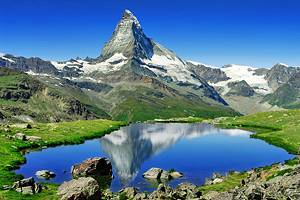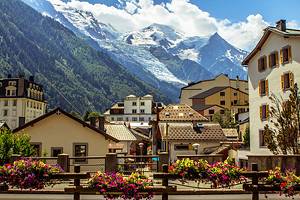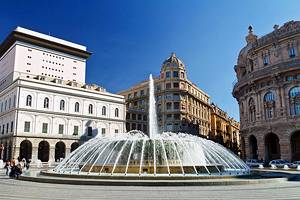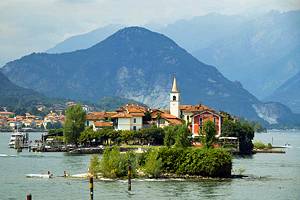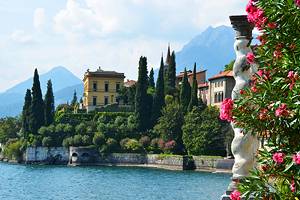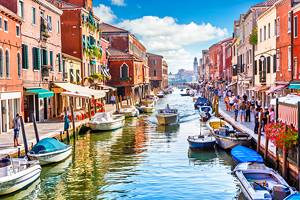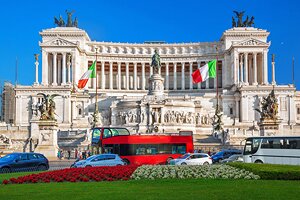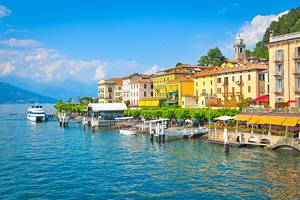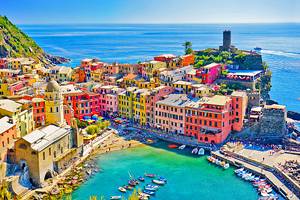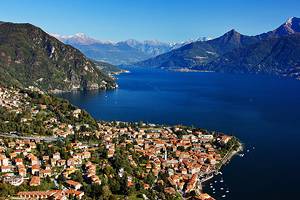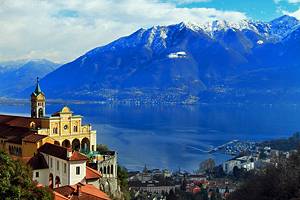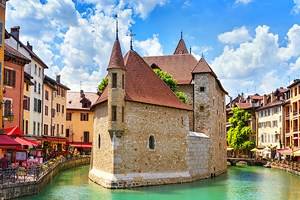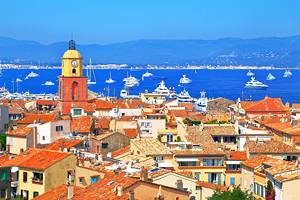Tourist Attractions in Turin
Despite its 20th-century history as Italy's industrial center, Turin (Torino) is an elegant and gracious city of wide avenues and squares lined by beautiful arcaded buildings. Long before it was the home of Fiat and Lancia, Turin was the seat of the powerful Savoy dynasty, and they were determined to make their capital city the rival of Paris and Vienna. Their palaces are its centerpiece, and the streetscape is the legacy of 17th-century Baroque architects Guarino Guarini and Filippo Juvarra.
Capital of the north Italian region of Piedmont, Turin traces its geometrical layout to its foundation as a Roman city, and an impressive gate from the time of Emperor Augustus is among its tourist attractions today.
After the French occupation under Napoleon, from 1798 to 1814, Turin became the center of the movement to unify Italy, a period known as the Risorgimento, when its glittering cafés rang with the discussions and plans of these activists.
The city seems to revolve around the broad Piazza Castello, bordered on one side by the Palazzo Reale and with the Palazzo Madama at its center. From here, the broad arcaded Via Po leads to Piazza Vittorio Veneto and the Po River. Find the best places to visit with our list of the top attractions and things to do in Turin.
- Museo Egizio (Egyptian Museum)
- Mole Antonelliana (Museo Nazionale del Cinema)
- Juventus Stadium
- Museo Nazionale dell'Automobile
- Palazzo Reale and Armeria Reale (Royal Armory)
- Piazza San Carlo
- Borgo Medioevale and Parco del Valentino
- The Cathedral and the Holy Shroud
- Palazzo Madama and Museo Civico d'Arte Antica
- San Lorenzo
- Santuario di Santa Maria Consolatrice (La Consolata)
- Day Trip to Reggia di Venaria Reale
- Museo Nazionale del Risorgimento Italiano (Risorgimento Museum)
- Galleria Sabauda
- Galleria d'Arte Moderna
- Porta Palatina
- Map of Tourist Attractions and Things to Do in Turin
Museo Egizio (Egyptian Museum)

Looking at Egyptian mummies and art may seem like one of the more unusual things to do in Turin, Italy, but, you won't find a better collection anywhere outside of Cairo, and it is Turin's most visited attraction. The Palazzo dell'Accademia delle Scienze houses the Egyptian Museum, whose collections began in 1824 when King Carlo Felice acquired 5,268 artifacts excavated in Egypt.
These were supplemented by later expeditions, and today, the collections contain statues of various gods and of pharaohs of the New Kingdom, including Rameses II and King Thutmose III, along with papyruses, painted linens, a group of Shawabti figures and a Shawabti box, canopic vessels, mummies and sarcophagi, and two tomb chambers from Thebes.
Address: Via Accademia delle Scienze 6, Turin
Official site: www.museoegizio.org
Mole Antonelliana (Museo Nazionale del Cinema)

From Piazza Castello, the arcaded Via Po runs to the Piazza Vittorio Veneto and the Po River. Just north of Via Po rises the huge Mole Antonelliana, begun by Alessandro Antonelli in 1863 as a synagogue, with a 168-meter-tall spire added in 1878 to 1880. Not only is this the most recognizable landmark on Turin's skyline, but the tower offers spectacular 360-degree views across the city to the surrounding hills and the Savoy Alps.
The ride to the top in the glass elevator is an experience you won't forget, as it provides a dizzying and dramatic look at the National Museum of Cinema, which occupies the interior of the building. The museum is perhaps best described by its designer, François Confino: "A full-immersion plunge into the world of images in motion and fiction." Even those with little interest in motion pictures will enjoy this museum, but you can also ride the lift to the top for a separate fee from the museum admission.
Address: Via Montebello 20, Turin
Juventus Stadium

Strictly for football (soccer) fans and a must-see for followers of Turin's Juventus, the stadium is officially called the Allianz Stadium, but in Turin it's simply known as The Stadium. You can visit to see the museum and take a guided tour through the facilities, visiting the locker rooms, press box, and the pitch itself (but not a chance to sit in the stands).
Tours are offered in English, and exhibits in the museum are labeled in English, as well. In it you can see the trophy room, uniforms, memorabilia, and a film about the team and its fans. The shop is filled with Juv souvenirs. Note that the museum and stadium tour require separate tickets; one does not include the other.
Address: Corso Gaetano Scirea 50, Turin
Museo Nazionale dell'Automobile

The National Automobile Museum provides a comprehensive survey of the development of the motor car, with special attention to the Turin auto manufacturers, but by no means limited to them. The collection of antique and classic cars is outstanding, and multimedia exhibits tell their stories and put automobiles in a social and cultural context as well.
Among the cars you'll see here are multiple models of FIAT and Alfa Romeo, plus Italian makers Ferrari, Lancia, Maserati, Auto Bianchi, and Bugati. But you'll also find examples of Jaguar, Rolls Royce, Mercedes Benz, even a Packard Super 8 and a BMW Isetta.
Address: Corso Unità d'Italia 40, Turin
Palazzo Reale and Armeria Reale (Royal Armory)

Filling an entire side of the large Piazza Castello in the center of Turin, the former Royal Palace is a relatively plain 17th-century building, at least on the outside. But step inside to be dazzled by the Appartamento di Madama Felicità and 26 sumptuously decorated state apartments (Reali Appartamenti).
In the right wing, the former Royal Armory (Armeria Reale) contains one of the largest collections of arms and armor in Europe, with complete suits of armor and other items dating from the 15th to 19th centuries. The library, which has a separate entrance to the far left, is one of Italy's most impressive.
Beyond the Palazzo Reale are the beautiful Royal Gardens (Giardini Reali) at the corner of which (the entrance is on Corso Regina Margherita) is the Museo d'Antichità, filled with archaeological finds dating from prehistoric times through the late Roman era.
Address: Piazzetta Reale, Turin
Piazza San Carlo

Turin is a city of beautiful squares and avenues, but no place is lovelier than the arcaded Piazza San Carlo, surrounded by arcaded buildings and punctuated at one end by the matching facades of the churches of Santa Cristina and San Carlo. Beneath the arcades are some of Turin's most stylish shops and the historic cafés where Italy's Risorgimento was plotted in the mid-1800s.
In the center of the square stands an imposing equestrian statue of Duke Emmanuel Philibert (1838), who seems to be choreographing the activity below. Look on the pavement under the arcades for the works - often in progress - of Turin's talented chalk artists. Also under the piazza's arcades (as well as those along nearby Via Po) are some of the favorite places for shopping in Turin.
Borgo Medioevale and Parco del Valentino

When you need a break from sumptuous palaces and grand architecture or are looking for free things to do in Turin, stroll toward the river and into the long green Parco Valentino. Here, you'll find Turin's own "folly" - a complete "medieval" village, an imaginative view of what one might have looked like, complete with its own castle, artisans' studios, and shops. Built for an exhibition in 1884, the borgo became such a local favorite that it has been maintained as part of the park.
Craftspeople sell and demonstrate period skills (if your suit of armor needs repairs, this is the place), and on weekends there are often hands-on activities, making this one of the city's favorite places to visit for families.
The park's lovely riverside setting so close to the historic and business center and its other attractions - the 1729 Botanic Gardens and the Savoys' fine Renaissance Castello del Valentino (1630-60) - make the park popular with locals and tourists. It's also a good place if you're looking for active things to do; the vehicle-free Viale Virgilio runs the entire length of the park, past restaurants overlooking the river. There's a boat landing where you can board the glass-enclosed boats for a river cruise.
Address: Corso Massimo d'Azeglio, Turin
The Cathedral and the Holy Shroud

Adjoining the Palazzo Reale, the Cathedral of San Giovanni Battista was Turin's first example of Renaissance architecture, built between 1492 and 1498. The cathedral's main attraction to tourists is the Santa Sindone, Holy Shroud, which although only rarely on view is kept in a bulletproof, fireproof, and climate controlled vault behind the altar in the left transept.
A full-size replica hangs in the north aisle of the cathedral. The Holy Shroud is quite possibly the world's most studied and controversial artifact, but despite the studies and the research, it has never been proven or disproven to be the shroud of the crucified Christ.
Address: Piazza San Giovanni, Turin
Palazzo Madama and Museo Civico d'Arte Antica

The large Palazzo Madama is the centerpiece of Piazza Castello, standing alone in its center. At its core is a 13th-century castle built on the remains of the Roman east gate. The castle was enlarged in the 15th century and embellished by Filippo Juvarra in 1718 with the handsome west front - a fine example of Piedmontese Baroque architecture - and the magnificent double staircase.
Inside is the Museo Civico d'Arte Antica (Civic Museum of Ancient Art), where you can discover Turin's history and artistic legacy from the ground up - literally. Begin in the Roman foundations with the collection of medieval stone work, sculptures, and jewelry; on the ground floor discover the 15th-century castle and art of the Middle Ages and Renaissance, along with the grand staircase and medieval courtyard.
On the first floor, the richly appointed 17th- and 18th-century state apartments hold collections of paintings and period furniture, and on the top floor are decorative arts, including ceramics, ivories, jewelry, fabrics, and glasswork from various eras.
Address: Piazza Castello, Turin
San Lorenzo

Don't judge the church of San Lorenzo, next to the Palazzo Reale, from the outside - step inside this Baroque (1668-80) masterpiece by Guarini and look upward for a surprise. Architecturally, San Lorenzo is considered one of the world's great churches for its unusual and boldly designed dome and lantern.
The round domed center is surrounded by eight curved bays and supported by intersecting ribs that support the lantern. Standing directly under its center, the symmetry and pattern of light from the windows makes it appear almost as a kaleidoscope. Notice the exuberant Baroque altar, too.
Address: Piazza Castello, Turin
Santuario di Santa Maria Consolatrice (La Consolata)

The Madonna was honored on this site as early as the fourth century, but the oldest part remaining is the Romanesque campanile, which was built sometime around AD 1000. When Guarini rebuilt the church in 1678 as a sanctuary dedicated to Mary, he retained the early tower.
His Baroque pilgrimage church is a feast for the eyes inside, lavishly decorated in colored marble inlay; pilgrims have added ex votos ever since its completion. In 1729, Filippo Juvarra added the oval chapel.
Address: Piazza della Consolata, Turin
Day Trip to Reggia di Venaria Reale

Although it's only about 14 kilometers from central Turin, you'll need a day to see one of the world's largest royal residences. Designed as a hunting lodge for the Duke of Savoy, Carlo Emanuele II, in 1675, its Baroque grandeur and ostentation fit in with the Savoy's determination to make Turin "The Paris South of the Alps."
Although listed as a UNESCO World Heritage Site, the palace is not well known. Combined with its size, this means that it is rarely crowded, and you can explore its grand galleries, residential apartments, and extensive formal gardens at leisure.
Highlights are the impressive Grand Gallery, the elegant Hall of Diana, and the Capella di Sant'Uberto and soaring Royal Stables, the latter two designed by Filippo Juvarra in the early 1700s. At the choreographed fountain shows in the Water Theater, 100 jets send water as high as 12 meters, while colored lights play through them.
Buses run regularly to the palace from Piazza Castello and Piazza Vittorio Veneto.
Address: Viale Carlo Emanuele II, Turin
Official site: https://www.lavenaria.it/en/visit
Museo Nazionale del Risorgimento Italiano (Risorgimento Museum)

Near Piazza Castello, Palazzo Carignano (by Guarini, 1679-85) was the meeting place of the Italian parliament from 1861 to 1864, and it was here that the establishment of the Kingdom of Italy was proclaimed on March 14th, 1861. It's appropriate that this should now be the home of the Museum of the Risorgimento, which commemorates the movement that made unification possible and in which Turin played such an important role.
This is the largest museum of its kind, with mementos and relics of the campaign for Italian unity and of the two world wars displayed in 30 rooms. While this might sound overwhelming, the museum is so well organized and its displays so well presented with interactive exhibits, films, and audio tours that it creates a fascinating story even for those not well versed in Italian history.
Conveniently, you can choose an audio tour route based on your level of interest and time available, from 45 minutes to two hours.
Address: Via Accademia delle Scienze 5, I-10100, Turin
Galleria Sabauda

Inside the Palazzo dell'Accademia delle Scienze is the Galleria Sabauda, an art museum containing some of Turin's greatest treasures. The collection includes pictures by the Piedmontese artists and by the Venetians Mantegna (Madonna with Saints), Paolo Veronese, Tintoretto, Tiepolo, and Canaletto, as well as notable works of Tuscan artists including Beato Angelico's Angels in Adoration.
The extensive collection of Dutch and Flemish paintings includes works by Jan van Eyck; Rogier van der Weyden; Hans Memling; Van Dyck; and Rembrandt, who is represented by an early painting, Old Man Asleep. One room is devoted to the Gualino Collection, with pictures by Botticelli and Veronese.
Address: Via Accademia delle Scienze 6 (enter from Via XX Settembre 86), Turin
Galleria d'Arte Moderna

The Galleria d'Arte Moderna contains one of the finest collections of modern art in Italy, with about 45,000 works in its collections. The concentration is on Italian artists such as Modigliani, De Chirico, Carrà, De Pisis, and Guttuso, but the collections have a number of works by Renoir, Utrillo, Paul Klee, Max Ernst, Chagall, and others.
The museum's slogan "All Art Has Been Contemporary" reminds viewers that works considered unconventional in their day (or brushed aside as inconsequential) are now staples of fine arts sought by the world's leading museums.
Address: Via Magenta 31, Turin
Official site: www.gamtorino.it/en/
Porta Palatina

Via Garibaldi was the Decimus Maximus, the main street of the Roman city of Augusta Taurinorum. Near the cathedral, you'll see the imposing first-century gate, Porta Palatina, the only remaining of the four entrances to the Roman city. One of the best-preserved Roman gates in the world, Porta Palatina's three-story wall is constructed of brick and connects a pair of polygonal brick towers.
According to legend, Charlemagne camped below the gate in 773. Beside the cathedral are the remains of a Roman theater, also from the first century AD. Only part of it is visible, the rest of it having been covered over by the royal palace buildings.
Address: Via Aosta, Turin
Map of Tourist Attractions and Things to Do in Turin
More Related Articles on PlanetWare.com
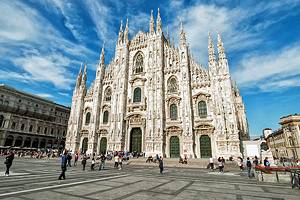
Where to Go from Turin: Several appealing cities are nearby, some close enough for a day trip from Turin. If a look at Turin's palaces whets your appetite for more, you'll find a number of them in Tourist Attractions in Genoa & Easy Day Trips. Or you can visit Milan with the help of our article on the Tourist Attractions in Milan.
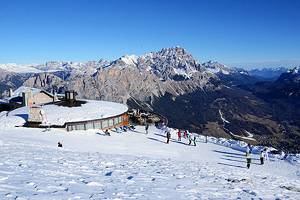
Finding the Best Alpine Skiing: Turin, which was the venue for the 2006 Winter Olympics, is a good base for skiers and winter sports enthusiasts. Several of Italy's best-known ski mountains are close to the city. Two of these, Courmayeur and Breuil-Cervinia, both north of Turin in the Val d'Aosta, are among the top ski resorts in Europe.





